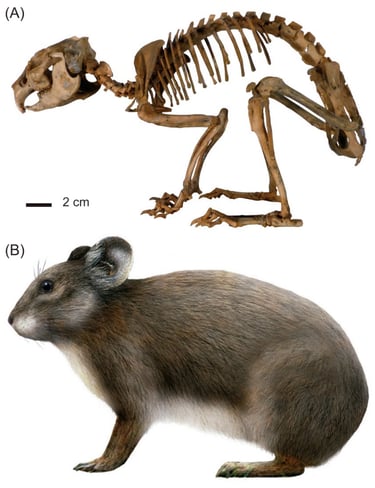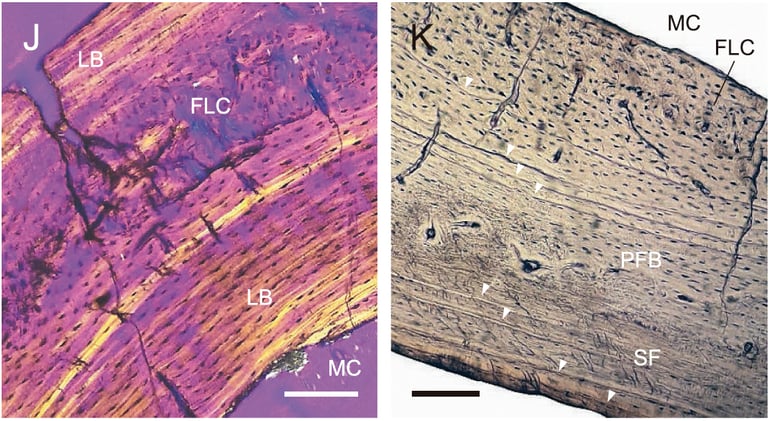
Bone histology of Prolagus sardus
We published a new paper about the bone histology and life history of the extinct P. sardus lagomorph.
RESEARCH
9/29/20233 min read
This week, our last research about the osteohistology and skeletochronology of the giant pika Prolagus sardus (a relative of extant rabbits and hares) has been published to the renowned journal Zoological Journal of the Linnean Society. In the following link, you can find the paper: https://doi.org/10.1093/zoolinnean/zlad112.
The genus Prolagus appeared in central Europe about 20 Mya (Miocene), and it was rapidly distributed for all Europe. This genus is related to the extant lagomorphs, however its taxonomical position is currently under discussion. Some authors had classified it as an ochotonid (extant family where the pikas are included), but others recognized it as a new lagomorph family. The preliminary analyses of DNA are promising for solving this issue. Prolagus sardus was an endemic species that inhabited Corsica and Sardinia from the Middle Pleistocene to the Holocene and it is the last representative of its genus (Figure 1). When P. sardus lived, Sardinia was full of rodents (murids, cricetids, gerbillids), moles, shrews, deer, elephants, mustelids and even canids.
Prolagus sardus is a very interesting species to research because it can provide clues to understand the response of lagomorphs to insularity. Assessing the hard structure at microscopic level, palaeontologists can unravel meaningful details about their biology, which are not possible to gain with traditional anatomical approaches. In this regard, we analyzed 15 histological slides (Figure 2) of an ontogenetic series of P. sardus (with immature and adult individuals) as well as others from extant pikas for comparison purposes. The bone tissues of the slides were classified, and several growth marks were recorded. What did we find?
The youngest individual shows a weaning line, consequence of the stress period of diet change. The inference let us to reveal that the weaning was produced around 55-60% of adult size. In other words, the pups of P. sardus were weaned at large size.
The accurate assessment of the histological slides evidenced that the growth declines around the third year of life, where the individuals only show residual growth. Considering its body mass, the species should be adult at the first year of life. In other words, the species' maturation was delayed in its life cycle.
Finally, the largest individual had an age of eight. This is a much-extended lifespan if we consider its body mass (which pointed a mean lifespan of 5 years). In other words, P. sardus lived longer than expected for its size.
Such kind of biological traits are observed in species that live in environments with a decreased extrinsic mortality and are typical of taxa that are more efficient in resource acquirement and allocated less energy to early reproduction. This is in agreement with the selective pressures of insular domains.
Previous studies ensured that P. sardus was the favorite prey of the Sardinian canid/dhole Cynotherium sardous, exerting a high pressure over this lagomorph. Contrary to this, the life history traits and strategy of P. sardus reveled in our study do not match with these high levels of predation. This suggests that the pressure of the canid was not as extreme as some researchers have hypothesized, or that the species may have adopted several biological and behavioral strategies to face predators. This calls into question the ecological networks assumed in the Pleistocene of Sardinia, and launch new clues to understand the environments of Sardinia during the Pleistocene and the gigantism process consequence of isolation.
Figure 1. Prolagus sardus: (A) mounted skeleton (PAL 167613). Credits: M. Brett-Surman, Smithsonian Institution National Museum of Natural History, CC0; and (B) artistic reconstruction. Credits: Prolagus sardus, CC BY-SA 3.0.
Figure 2. Bone histology of Prolagus sardus specimen R5 (adult, eight LAGs) showing the anteromedial region (J) with FLC surrounded by LB in the inner and outer cortex and posteromedial region (K) with eight LAGs (arrowheads). Scale bars equals 100 micrometres. Credits: Fernández-Bejarano et al., doi: 10.1093/zoolinnean/zlad112.
Fernández-Bejarano, E., Blanco, A., Angelone, C., Zhang, Z., Moncunill-Solé, B. In press. Bone histology of the Late Pleistocene Prolagus sardus (Lagomorpha, Mammalia) provides further insights into life-history strategy of insular giant small mammals. Zoological Journal of the Linnean Society. DOI: 10.1093/zoolinnean/zlad112.
Check the X thread 🧵about the most relevant things of this publication here.




